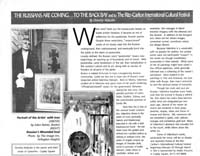 |
The Russians are coming…to
the Back Bay and Ritz-Carlton International Cultural
Festival
By Dorothy Malcolm
|
Click
to see larger image |
|
Article first appeared in
"The Newbury Street Guide Newspaper," February
1996, Jacaranda Publishing, Boston.
Article picked-up in "The Fine Arts Trader Magazine,"
September 1996 issue, Sanbro Publishers, Boston.
When Josef Stalin put the bureaucratic breaks on Soviet
Russian artistic freedom, it became an era of wilderness
for the passionate, Russian psyche. Despite those restrictions,
“unsanctioned” works of art slowly crept into
the Russian underground, then mainstreamed, and eventually
bust into the public at the dawn of perestroika.
Loosely defined, the Russian word “perestroika”
means new beginnings, an opening up of boundaries as well
as minds. With perestroika, came breakdown of the old, then
revitalization in the country’s culture and its art,
along with an exodus of Russians to all parts of the globe.
Boston is indeed fortunate to have a burgeoning Russian
community. Lucky we are also to have one of Russia’s
most respected artists, Valentina Nekrash. Born in Siberia,
Valentina studied art in Moscow and spent most of her youth
rendering “official, sanctioned” works for the
government. Between raising her two sons, she painted portraits
of Lenin, Stalin, Pushkin, Tolstoy and the (sanctioned)
epitome of Soviet life.
Now that she is free of the coerced Soviet conformism,
Valentina shines in the realm of icons (primarily Saviors
and madonnas) executed in oil with a deft impressionist
hand. Yet she never loses that golden and refined but crackled
patina, which she fashions that are so striking in original,
antique icons. Her series of angels conjure up images of
Dresden dolls, some in postures of ballet dancers, while
others in crestfallen defeat and weariness. She manages
to blend emotional imagery with the ethereal and the visceral.
In addition to her liturgical arts, there are her dream
images, somewhat surreal, sometimes veiled, but always vibrant.
Because Valentina is a universalist with no passion for
politics, her private works were not particularly “suspect”
in the Soviet era, though nonetheless provocative in their
naïveté. While some of her oil paintings might
have raised a few official eyebrows, what generally followed
was a softening of the viewers’ perception. Most evident
in her art is, first and foremost, her love affair with
Russia, then man’s immortality, and the spiritual
sweep of humanity.
Though her roots and soul are Russian, Valentina breathes
more freely now that the turmoil in Russia is behind her.
She claims her colors have become softer since she immigrated
to Boston just two years ago. Several of her newer abstracts
are rendered in dove grays, peaches, taupes, olives and
traces of mauve and sienna. Still, numerous oils are sheathed
in her signature golds, reds, yellows, oranges and sometimes
gold leaf. Many of Valentina’s abstracts feel, visually,
hot to the touch, while others shiver like white ice.
Some of Valentina’s works, particularly her icons,
will be on display and will represent Russia at the Ritz-Carlton’s
International Cultural Festival beginning February 20 through
March 4. She is represented by Atelier Panache in Copley
Square
|
